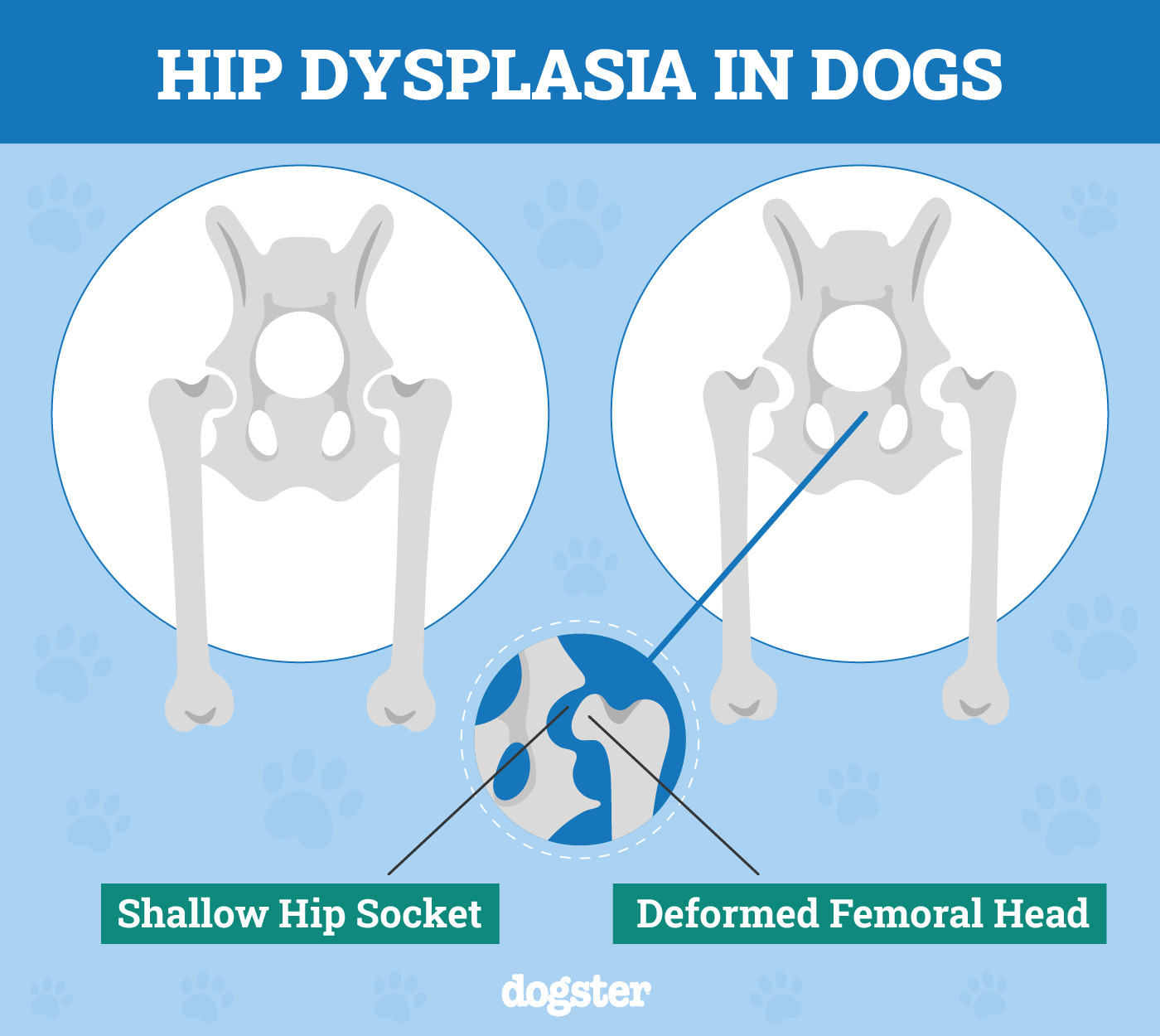Australian Shepherds, or Aussies, are a popular dog breed among people with active lifestyles. This high-energy breed certainly keeps people on their toes while providing loyal and loving companionship. What makes this breed even better is that they are a generally healthy dog breed, especially if you purchase a pup from a respectable breeder who performs all of the recommended health tests on their breeding pairs.
While they are generally a healthy breed, that doesn’t mean they are immune from problems. There are multiple problems that do pop up in the breed, and it’s important to know what your Aussie may be at risk for. We will discuss 13 of the most common conditions, but there are more, so do not consider this list all inclusive.
The 13 Australian Shepherd Health Issues
1. Hip Dysplasia
Hip dysplasia is one of the more common conditions you might see in an Aussie, although it is less common in well-bred dogs from health-tested parents. This condition is characterized by looseness within the hip joint itself, leading to the cartilage and bone of the hip to wear down over time. Without treatment or preventive measures, hip dysplasia will worsen. This condition may show up very early in life but also may not produce any signs until your dog is a few years old.
This condition can be managed in many ways, with pain killers, joint supplements, weight management, and physiotherapy, but sometimes, surgical replacement of the hip joint may be required. This surgery usually is performed by a board-certified veterinary orthopedist or surgeon. Without surgery in the most severe cases, hip dysplasia will worsen over time, causing the dog a lot of pain, although some joint supplements can help reduce the rate of wear on the hip. An exercise plan designed by a professional may help strengthen the muscles around the hip, decreasing your dog’s discomfort over time.

2. Elbow Dysplasia
Elbow dysplasia is the same thing as hip dysplasia except within the elbow joint. It is far less common than hip dysplasia, although it does still occur with some frequency within the Aussie breed. Also, like hip dysplasia, elbow dysplasia will worsen over time and can appear very early in life or later in life.
This condition can be managed through supplements, medications, and an appropriate exercise regimen. Few surgical options are available for dogs that do not respond to medical management.

3. Cranial Cruciate Ligament (CCL) Injuries
The CCL is a ligament that dogs have in their knees that helps with the stability and support of the knee joint and the leg itself. It is the most common joint injury in dogs, and Aussies are at risk for it due to their risk for joint problems and their high activity level. This injury usually occurs during activities like running, agility, and jumping.
CCL injuries are sometimes left to heal with rest, which can take weeks or months. If the CCL has been mostly or fully torn, though, then surgery is required to fix the problem. There are a few surgical techniques that can be used, and your primary vet may or may not feel comfortable fixing this injury. In many cases, an orthopedic surgeon must repair the ligament.
4. Cataracts
A cataract is a clouding of the lens of the eye that can lead to vision problems and blindness. They can occur in one or both eyes. The disease, in this case, is hereditary, although it can also happen in dogs with no known genetic risk. However, it can also occur due to other medical conditions, like diabetes, so make sure to have your dog checked out from nose to tail if you suspect cataracts.
Cataracts can be surgically corrected, but this procedure is done by a veterinary ophthalmologic surgeon and can be quite expensive. Without treatment, your dog will go blind or may develop glaucoma. The good news is that cloudy eyes are not always cataracts. Older dogs often develop nuclear sclerosis, which is not a serious problem, and it can look like a cataract to the untrained eye.

5. Progressive Retinal Atrophy
Progressive retinal atrophy is not a disease on its own, but it is a group of diseases that impact the retina of a dog’s eye or eyes. The retina becomes atrophied, or wastes away, in all of these conditions. Over time, this atrophy will worsen, eventually leading to blindness. Since there are different types of PRA, dogs of any age can be impacted, with some as young as 2 months receiving a diagnosis.
The earliest signs of problems with your dog’s retinas will be a decrease in their night vision abilities. However, it will eventually begin to impact your dog’s ability to see in bright light. Unlike cataracts, PRA is not painful for your dog, but blindness can be stressful for your dog and the other members of the household, although dogs tend to adapt well and use other senses to compensate for loss of vision. There is no treatment for this condition, though.
6. Distichiasis
Distichiasis is a condition in which a dog’s eyelashes develop from the wrong portion of the eyelid, developing from the margin of the eyelid instead of the skin of the eyelid. This can lead to a dog’s eyelashes rubbing against the eyes, leading to painful ulcers. If left untreated, ulcers can lead to corneal scarring.
There are non-surgical treatments for this condition, including treating the eye with medications to lubricate and protect it, and plucking the eyelashes in the case of only a couple of lashes being out of place. In more severe cases, your dog may require surgical treatment. There are a variety of surgeries that can treat this procedure, and they range from non-invasive to invasive, using electrocautery, cryosurgery, or laser, depending on the severity of the condition and how it has responded to previous treatments.

7. Collie Eye Anomaly
Collie eye anomaly, or CEA, is a disease of the eyes that is inherited from the parents due to a gene that causes inappropriate development of the eye. It typically occurs in Collies, Shelties, Aussies, Border Collies, and Nova Scotia Duck Tolling Retrievers. Usually, there are notable physical abnormalities in the eyes that don’t cause pain or blindness. In some cases, dogs can be born blind with or develop blindness.
While there are surgical procedures that can correct some problems with the eye, most cases of CEA are not treatable. This usually has no bearing on the quality of life that your dog has, but it may require vigilance on your part to closely monitor the eye for changes and damage.
8. Iris Coloboma
Iris coloboma can be part of the CEA and means that the part of the iris may not have developed properly. It generally has very little effect on the dog’s vision, unless it’s large, which may cause squinting. Merle Aussies are more prone to this hereditary issue, and one in seven dogs may have it. Get your vet or a veterinary ophthalmologist to examine your puppy’s eyes.

9. Hypothyroidism
Hypothyroidism is a disease that causes the decreased function of the thyroid gland. This is not an uncommon condition in general in dogs, and it also occurs in other species, including cats and humans. This condition can cause a variety of signs, including lethargy, weight gain, difficulty losing weight, and changes to the skin and coat. Some dogs just seem to be more susceptible to developing this condition, although there is a genetic component to it. Often, the cause is an auto-immune disorder called thyroiditis and is one of the most common auto-immune disorders in Aussies.
This condition is treatable through medications, although your dog will require medications for life and routine labs to ensure their thyroid levels are appropriate. It is extremely common for dogs with hypothyroidism to become obese, and it is very difficult to help them lose weight. It will be extremely important for you to maintain your dog at a healthy body weight through an appropriate diet and exercise. It’s advised not to breed dogs with known hypothyroidism.
If you are concerned about the health and well-being of your pet, we recommend getting in touch with a vet for guidance.
If you need to speak with a vet but can't get to one, head over to PangoVet. It's our online service where you can talk to a vet online and get the advice you need for your dog — all at an affordable price!
10. Epilepsy
Epilepsy is a neurological disorder that results in seizures. There are multiple reasons for seizures to develop outside of epilepsy, like brain tumors and toxin exposure, so it’s important to not just assume that your dog has epilepsy if they begin having seizures. Epilepsy can be a genetic condition with complex inheritance, and the majority of epilepsy in such cases are idiopathic or without a known cause.
There are multiple anti-seizure medications on the market, so there are often multiple options when your dog starts medications. Some medications have more risks and side effects than others, so make sure to discuss the pros and cons of a medication with your vet.
Sometimes, multiple medications are necessary to keep a dog’s epilepsy under control. If your dog ever begins experiencing multiple seizures in a row or a seizure that is not ending, then this is a medical emergency and should immediately be addressed by a vet.

11. Lymphoma
Lymphoma is a type of cancer that develops within the lymph nodes in the body. The lymph nodes are a vital part of the circulatory and immune systems. Due to the fact that lymph nodes are scattered throughout the body, lymphoma has a high risk of metastasizing. In severe cases, it can develop inside organs.
Lymphoma is a dangerous variety of cancer that many dog breeds are prone to developing, including the Aussie. If caught early, there are multiple treatment options available for lymphoma. However, it can be easy to miss the early signs of cancers, allowing them to grow and spread before signs can be noticed. Remission is possible with chemotherapy, but the illness will eventually return. It is believed that lymphoma has a genetic component that increases an individual dog’s risk of developing this type of cancer.
12. Hemangiosarcoma
Hemangiosarcoma is another type of cancer, and while some dog breeds are especially prone to developing it, like Labs and Golden Retrievers, it does also occur in Aussies. This type of cancer can develop in multiple internal organs, with the spleen being the most common location of the primary tumor.
What makes hemangiosarcoma so difficult to deal with is how insidious it can be, as well as how difficult it can be to treat. It’s not uncommon for people to not realize their dog has hemangiosarcoma until they develop internal bleeding and the situation becomes deadly. Some types of hemangiosarcoma can be managed with chemotherapy, but this cancer typically has a very poor prognosis.

13. Multi-Drug Sensitivity
Multi-drug sensitivity is caused by a mutation of the MDR1 gene, also sometimes called the ABCB1 gene. This mutation alters the body’s ability to protect the brain from medications, as well as effectively metabolize and excrete them. This means that dogs with this condition are exceptionally sensitive to many medications, and they may experience overdose signs, even with appropriate doses.
This condition is most common in herding breeds, including the Aussie. Although Aussies are prone to this condition, there is a DNA test that can help identify this gene mutation with fairly high accuracy. Your vet will be able to give you the best guidance when it comes to keeping your Aussie safe with medications.
 Conclusion
Conclusion
Overall, Aussies are usually generally healthy dogs, but it is important for you to do your due diligence when it comes to researching breeders and monitoring your dog’s health throughout their life. Look for a breeder who performs all recommended health testing on their breeding dogs before they breed them, and who doesn’t breed dogs that develop or show a genetic predisposition to certain conditions.
See also:
- Do Australian Shepherds Like Water? Breed Preferences Explained
- Do Australian Shepherds Like the Cold? Vet Approved Facts & Care Tips
Featured Image Credit: Eve Photography, Shutterstock




















2 Responses
We are very sad our 10yr old Aussie we adopted at 5yrs old has come down with kidney's failing and we are told he only has a few months left. He is such a great boy and probably our last do to our age.
Hi Gary,
I’m so sorry to hear about your loss. It’s clear he was deeply loved and had a wonderful life with you since you adopted him. Giving a dog a second chance and a loving home is such a beautiful act of kindness.
Thank you for your comment ❤️